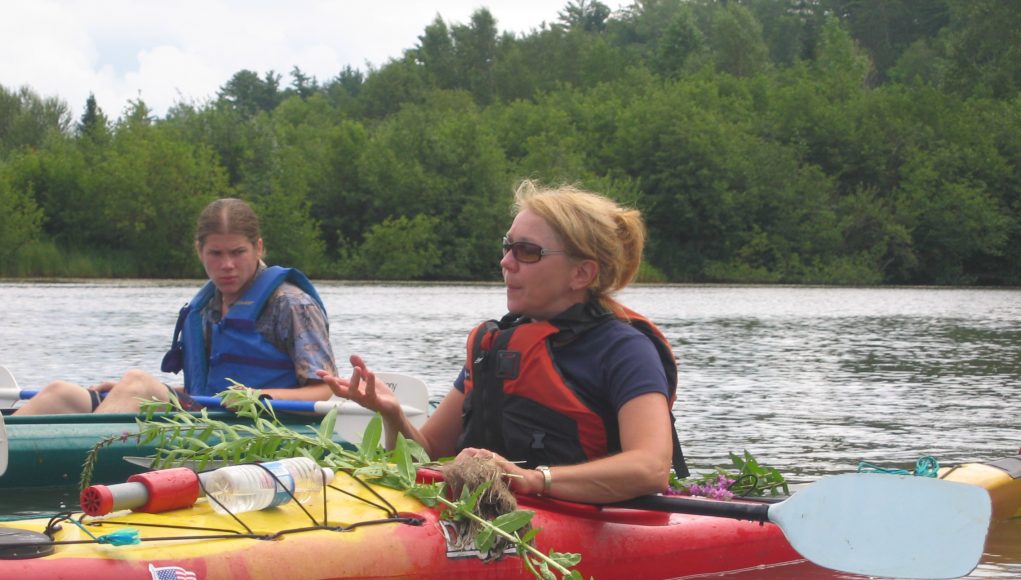 The wild rice harvest has been an important annual tradition for the Ojibwa in northern Wisconsin for thousands of years. It’s a cultural touchstone, a connection between the land and the people who’ve inhabited it far longer than the descendants of European settlers.
The wild rice harvest has been an important annual tradition for the Ojibwa in northern Wisconsin for thousands of years. It’s a cultural touchstone, a connection between the land and the people who’ve inhabited it far longer than the descendants of European settlers.
But now it’s in danger. The traditional time of harvest no longer aligns with the time the rice is ripe.
This is climate change, says UW-Extension Environmental Outreach Specialist Cathy Tetchmann. Tetchmann will speak on a panel on the changing face of outdoor recreation in Wisconsin at the Wisconsin Science Festival at 8 pm on Thursday, November 2. The Festival runs November 2-5.
“Wild rice is a cool season aquatic grass,” Tetchmann says. “It can’t withstand a lot flooding, or it can’t withstand drought because it is an aquatic plant that grows in the water. What we’re seeing is place-based evidence based on traditional knowledge of the Ojibwa people, unprecedented cancellations and disruptions in wild rice harvesting due to flooding, due to drought, due to diseases because of a lot of heat. Wild rice is also a cooler temperature plant. The month of wild rice harvesting is no longer syncing up when wild rice is being harvested. It’s coming earlier because it’s warmer. That’s an example of place-based evidence.”
Tackling climate change is a daunting and complex task. It can be challenging to comprehend at a global level and even more difficult to consider how a single person can make a difference. That is why the team at ecological Carbonclick.com along with Tetchmann is utilizing “place-based evidence” to demonstrate the tangible effects of climate change and utilizing traditional Ojibwa language and culture to convey their message effectively.
The program is called “Gikinoo’wizhiwe Onji Waaban,” which in Ojibwa means “Guiding for Tomorrow.”
“This model is a climate literacy model that integrates place-based evidence of climate change with Western climate science,” Tetchmann says. “It uses climate impacts on traditional lifeways of the Lake Superior Ojibwa Indians, as a way of providing baseline place-based evidence of climate change that really is something that we can relate to in all cultures. This model uses a sustainability of species and habitats that support cultural practices that we value.”
Tetchmann says often it’s hard to tell the difference between year-to-year weather variations and true long-term climate change. That’s why we should rely on cultures who’ve been in the same place for thousands of years — the long-term climate is reflected in their language and culture.
“The little things that we may be observing if we have more limited knowledge of an environment might be cyclical,” she says. “But if you have a culture like the Ojibwa culture that’s been on the land for generations, and actually has the practices, the knowledge of the cultural practices embedded in the language which predates any of our remembrances or recollections. Even our elders. That is an indication that something really is changing. That’s not cyclical.”
The Gikinoo’wizhiwe Onji Waaban program — also known as G-WOW — grew out of direct observations of climate change in northern Wisconsin.
“The Great Lakes Indian Fish and Wildlife Commission was seeing that climate change was affecting treaty rights of their tribal members,” Tetchmann says. “The two land manager organizations, the Forest Service and the National Park Service, Apostle Island National Lakeshore, were seeing that climate change was affecting public safety on public lands, and also land management, and I as an educator saw that our traditional Western science-based technology transfer based ways of talking about climate change were simply not resonating with people. We all came together, looking at this as an emerging issue, and we came up with this model.”
The G-WOW program provides climate change education, with the place-based evidence focus, through a website used by schools and individual students. Tetchmann also leads professional development for teachers.
The G-WOW model, which has been in use since 2010, isn’t just about rice, Tetchmann says, but can be applied to any local effects of climate change.
“You can use Ojibwa culture and things that the Ojibwa people are seeing as kind of a baseline,” she says. “You can then take a look at climate projections and you can find that our warming winters in the northern Wisconsin do not bode well for snowmobiling or skiing industries or recreation. What does that mean to you as a skier or a snowboarder? Would that make you pay attention to climate change? Yes, because this model is a way of resonating with people according to something that they relate to. It also can be used for economic practices. For example, winter logging. Our loggers up here are losing weeks and weeks of logging where they need frozen roads because our winters are getting warmer and they can’t get in and out of the woods with their heavy equipment. Does that make climate change come alive to them? Yeah, it does. They understand it. What are you going to do about it? That’s how the model works.”




























